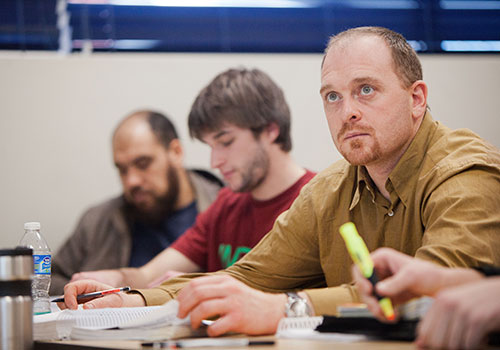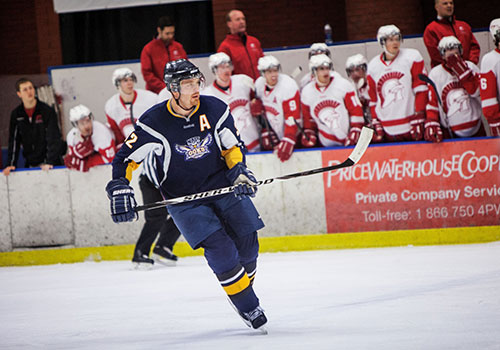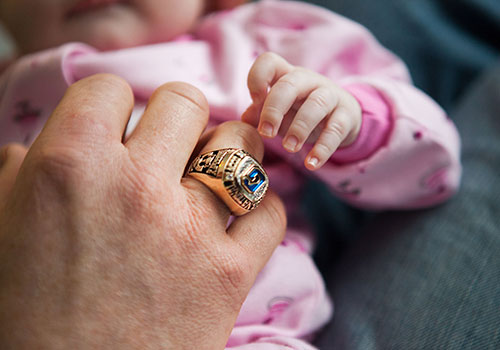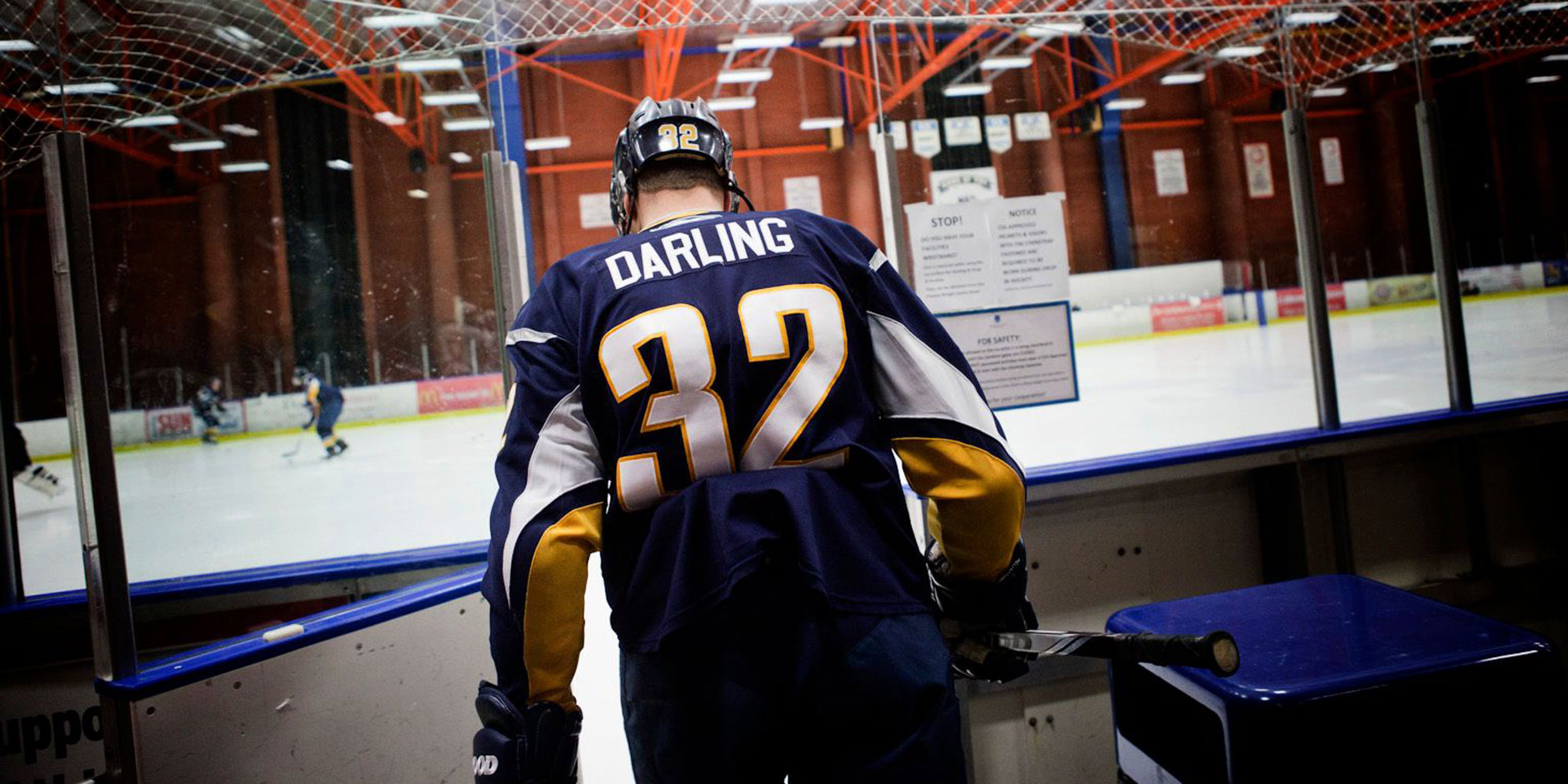A new start for one of the toughest names in hockey
Dion Darling stands behind his own net, hovering over the puck. It’s the first period of a game necessary to secure a playoff spot for his fourth-place NAIT Ooks men’s team (2010-11). They’re up 1-0, but as they’re being outshot by the second-place Mount Royal Cougars, it’s a tenuous lead.
A veteran defenceman and 1993 Montreal Canadiens draft pick, Darling knows the importance of strategy. He waits, drawing a Cougar forward toward him and away from the play unfolding up ice. One of the biggest guys in the rink at six-foot-three and 230 pounds, he banks the puck hard off the boards onto the waiting stick of a teammate.
It’s not a flashy play, but it’s smart, and in keeping with a calm, gritty style of play Darling developed over more than a decade in pro and leagues across Canada, the U.S. and Europe. Call him a grinder: a tough but talented workhorse unafraid to put both boards and body to use to shut down the opposition, like Bobby Clarke, Guy Carbonneau and Esa Tikkanen used to do.
“When you have someone like that in your lineup,” says Ooks men’s coach Serge Lajoie, “it makes everyone play a little bit taller, a little bit bigger.”
That, along with Darling’s “team-first” attitude, Lajoie adds, makes him a leader with the Ooks, who won their last Alberta championship in 1995-96.
The appreciation, however, goes both ways.
“Real life is a lot different from hockey life.”
“Real life is a lot different from hockey life,” says Darling, an Ooks rookie. Right now, the assistant captain is somewhere between the two.
He’s 36 years old and has a new daughter, Madilyn, with his partner Shayla. He knows his priorities have changed, and he knows that his first career – one he loved and devoted himself to since high school, when he played Junior B in Stony Plain and Midget AAA in St. Albert – is over.
This is a game-changing period of his life. The stakes are higher than any hockey game, of course, but in a way he’s still back behind his own net, trying to figure out how to set up the perfect play. He’s relying on this year with the Ooks, and NAIT, to make it happen.
Currently enrolled in NAIT’s 4th Class Power Engineering program, Darling represents a relatively common plight of the professional hockey player, and perhaps of the majority of pro athletes.
For retiring stars, the question of “What next?” is an easy one: move into coaching or management, profit from endorsements and business connections, live off grossly inflated earnings, or enjoy some combination thereof. But players like Darling, forced to be more self-reliant, find themselves turning to post-secondary institutes like NAIT.
There is, however, one issue common to all, and, if not properly handled, it can make the differences between the “hockey” and “real” worlds difficult to bear. It’s nothing short of a sense of loss, and part of the reason Darling feels driven to devote himself to his studies.
“Hockey’s been my life. Think about the one thing you enjoy the most and stop doing it,” he says.
“It’ll drive you crazy.”
 Back to school
Back to school
If you’ve never seen him play, the irony of Darling’s name is best appreciated through an Internet search, which calls up clips of his hockey fights.
Also, his stats show teams that took full advantage of him as an “enforcer” – a role he reluctantly accepted, and which saw him, in some cities, sit an average of more than four penalty minutes per game.
None of that compares to this year in the classroom. Going back to school full time after a 17-year absence, says Darling, is “tougher than the toughest fight of my whole career.”
“My first week, it was a big, big shock. I felt like I’d get my head out of water and then I’d get sunk back in. It’s an eye-opener,” he adds. “You have kids that are coming in out of high school and they’re still rolling. I guess my wheel stopped rolling for awhile.”
When he describes the Power Engineering curriculum, which covers the generation and distribution of power, he gravitates to topics like friction, stress, strain and pressure – all of which might easily be applied to balancing the roles of full-time student, new dad and hockey player committed to four practices and two games a week.
“I empathize. I have full understanding of what he’s going through,” says Lajoie, who (also as a dad) took his masters in coaching while playing for the Golden Bears at the University of Alberta. But, he adds, “This is his opportunity for a very good future. He knew exactly what he wanted.”
That’s true. Darling picked Power Engineering for a reason.
Darling has already worked a stint in industry. After returning home from playing six seasons in the U.K.’s Elite Ice Hockey League, he took a job leading a chemical crew in an industrial cleaning company. He hated it, for the simple reason that there was no sense of teamwork – and palpable resistance to his efforts to build that bond amongst his guys.
After coming from an atmosphere in athletics he describes as akin to brotherhood, Darling is still confused by that lack of connection. “I can’t wrap my head around it. I just think it should be natural.”
When his brother Shane (Instrumentation ’97), suggested he talk to a few industry types to find a field known for its collegiality, Power Engineering was a common response. Ever since, he’s thrown himself into his studies with the same commitment Lajoie says has earned him the respect of the Ooks.
“Any quiz or test, you have to treat it like it’s worth everything,” says Darling. “What you put into it is what you’re going to get out of it. I’m a firm believer in that.”
 The hockey player’s dilemma
The hockey player’s dilemma
As Jim Donlevy sees it, most hockey players face a similar situation.
“Everybody has told you since you were knee-high that you were going to make it to the show,” says the director of education services for the Western Hockey League (WHL). Reality differs.
“It’s safe to say that, of the number of kids who play in our league in any given year, a small percentage make a living long-term in the NHL.”
Unlike Darling, who admits to having focused on achievement at the rink rather than at high school, WHL players aren’t allowed to be left behind in the classroom anymore for exactly that reason.
“Managers, coaches, owners, they care for these kids,” says Donlevy. To prove it, the WHL provides post-secondary scholarships for each year played, to be used within a year of leaving the league. More than 400 players were eligible for the program this year – almost as many as those now playing.
Six of those scholarship students are currently enrolled at NAIT, with two – defenceman Ryan Smith and forward Jeff Topilko – playing for this season’s Ooks. (Darling, who went directly to the East Coast Hockey League following his 1993-94 WHL season, isn’t one of them.)
While they all have their own reasons for choosing NAIT, Lajoie makes his recruitment pitch on features including a wide selection of NAIT programs, a high grad placement rate, and small classes offering greater interaction between instructor and student.
For some players, however, the reason for coming to NAIT might simply be the Ooks. The team can be an opportunity to stay in the game, even if it means having to try to strike the balance between school and sport. The team can be a comfort, says Lajoie.
“There’s always that need to have that sense of belonging."
“There’s always that need to have that sense of belonging. That’s what you get from hockey.”
The reasons for playing may go deeper still, adds assistant coach Russ Hewson, which might explain why Darling, with all his other commitments, including that new baby girl, would play at all.
“It’s easy from the outside to say, Why is this guy still playing hockey?” says Hewson, a 35-year-old police officer and father of three who, eight years ago, also made the transition out of pro hockey.
“He’s got a [partner] now, he’s got a kid now, he’s going to school. Why play hockey? At the end of the day, to be a better person and a better husband and a better dad, I needed to be involved in hockey and I think Dion’s the same.”
But as Hewson admits, if you’re not going to the show, “to put it bluntly, you’ve got to grow up. Hockey’s a game. At some point, unless you’re playing in the NHL, we all need to get a real job.”
 The last game
The last game
The way Darling remembers it, life in hockey was exciting and unpredictable in ways most of us can only imagine: sipping drinks with celebrities at a Lakers basketball game between L.A. Kings try-outs, a (nearly) crash course in right-hand driving just hours after touching down to play in the U.K., a surreal stint in Russia while with the Kontinental Hockey League.
But after 13 years pro, he claims to have had enough of it all. Perhaps nothing makes that clearer than a diamond-encrusted, gold ring the size of daughter’s fist and featuring a blue “G” for the Bentley Generals, the last team Darling played for before the Ooks.
“Every hockey player’s dream is to get a championship ring,” he says. “You don’t realize how hard it is until you actually do get it.”
With the help of Darling, invited to join the Senior AAA Chinook Hockey League team by its coach Brian Sutter, the Generals won the storied Allan Cup, Canada’s top prize for amateur hockey, in 2009. It was the first Alberta championship in a decade and only the fourth in the tournament’s 102-year history.
“It’s a neat thing to say that you retired a champion,” says Darling.
In fact, he’s almost relieved by it. But as if to prove – more to himself than anyone else – that he’s ready to move on, he rarely wears that ring. Instead, it stays in a box as little more than a pricey keepsake.
Even if “retired,” Darling brings a pro’s game to the Ooks. He’s had to adapt to less tolerant officials, but he’s still playing the smart hockey that saw him on-ice for both goals (assisting one) of what ended as the Ooks’ 2-0 win over the Cougars, solidifying a playoff spot and a chance at the provincial championship.
And he’s still tough – maybe too tough. At the game’s end, Darling delivered a crushing hit as retribution for one on a teammate, drawing a two-minute penalty and a 10-minute misconduct.
Darling says he doesn’t intend to play seriously after the Ooks, when he’ll be focused on establishing his new career as a power engineer. He doesn’t want to coach; he favours pickup games over a rec league; if his daughter – or any kids to come – one day shows an interest, then he will, too.
But he will carry forward the attitude he brought to the game, along with everything he learned from it.
Inscribed inside that Allan Cup ring is a quote from Generals head coach Brian Sutter: “Always win your last game.” Darling has taken it to heart. On the one hand, its meaning is obvious: the last game makes the difference between finishing as a champ and just finishing.
The rules of the game apply on ice and off.
On the other hand, it speaks to preparing for the future, whatever it holds. It seems to imply that the rules of the game apply on ice and off.
“The older you get the more you realize what you have to do,” says Darling. “One of the things Brian Sutter emphasized is if you get complacent, you’re in trouble.”
Now moving out of the “hockey” world and, through NAIT, into the “real” one, he understands the challenge of the adjustment he’s facing. But he also believes that, if he's willing to work at setting up the right play, and to grind through with some strategy, perseverance and patience, he might do as well in one world as he did in the other.
"If you put in a good effort,” says Darling, “hopefully it will show.”
